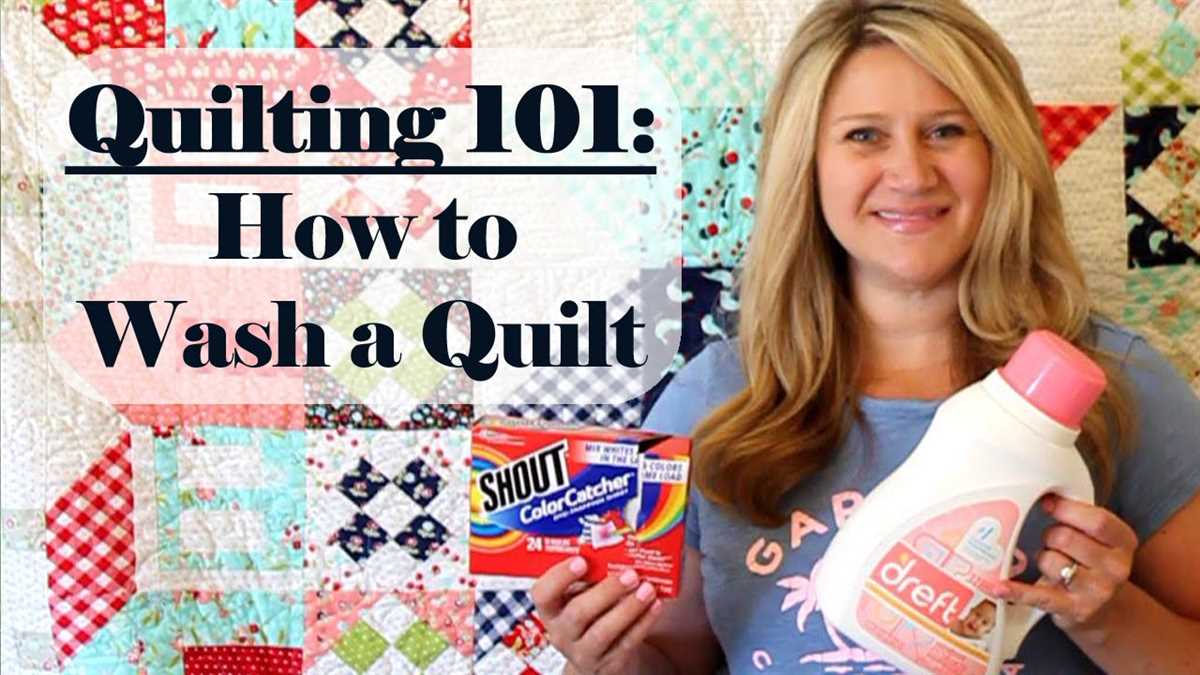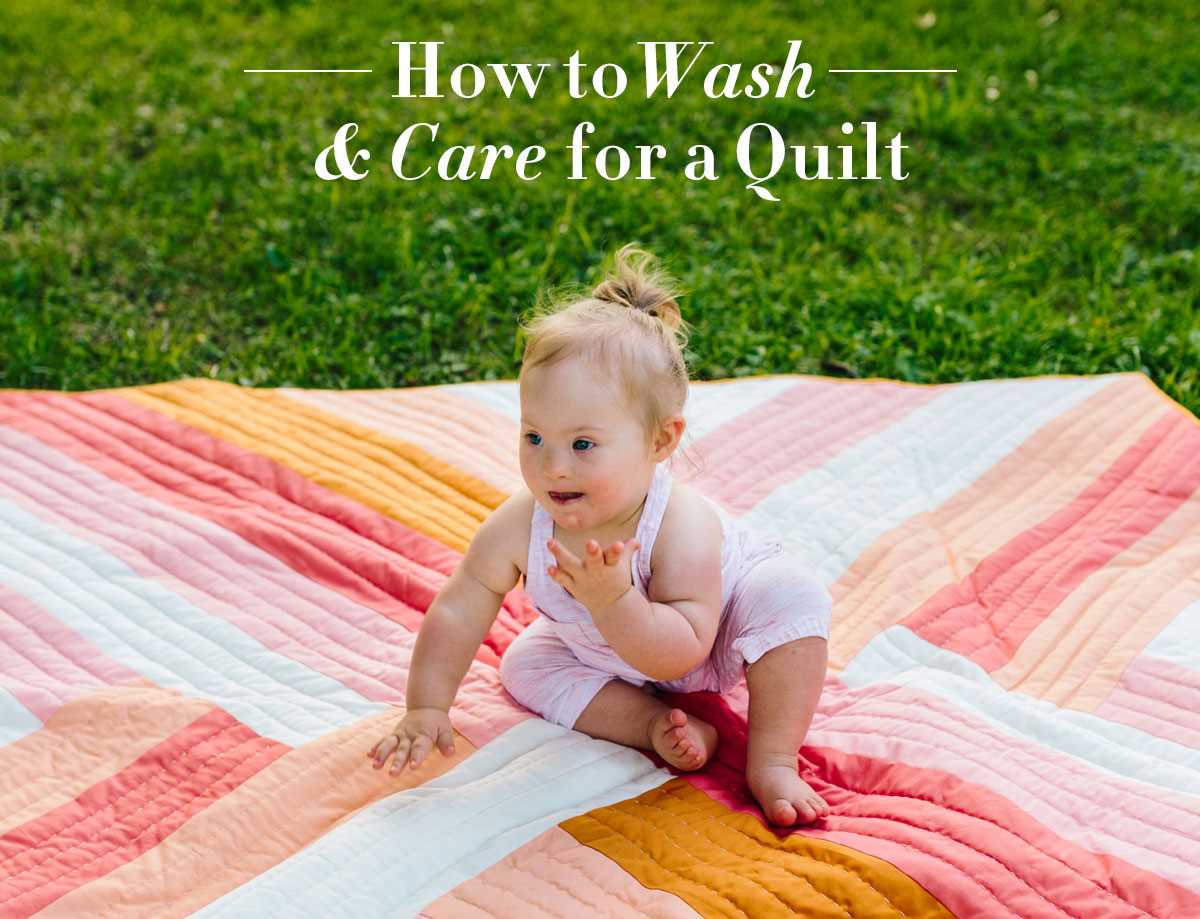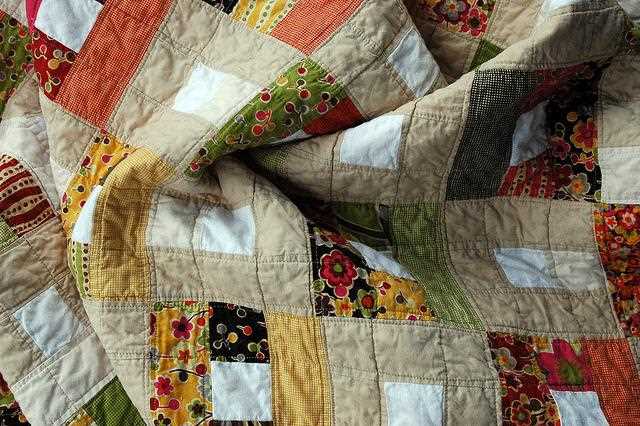




Quilts are cherished heirlooms that provide warmth and comfort. They can also be a beautiful addition to any home decor. However, over time, quilts can accumulate dirt, dust, and stains, making them look dull and worn. Washing a quilt may seem like a daunting task, but with the right techniques, it can be done easily and safely. In this ultimate guide, we will provide you with step-by-step instructions on how to wash a quilt properly.
Step 1: Assess the Quilt
Before washing the quilt, it is important to assess its condition. Check for any loose threads, weak seams, or delicate embellishments. If the quilt has any delicate or fragile areas, it may require special care or even professional cleaning. Also, take note of any stains or spots that need attention.
Step 2: Pre-Treat Stains
If there are any stains on the quilt, it is best to pre-treat them before washing. Use a gentle stain remover or a mixture of mild detergent and water to spot-clean the stains. Always test the stain remover or detergent mixture on a small, inconspicuous area of the quilt first to ensure it does not fade or damage the fabric.
Pro Tip: If the quilt has mildew or a strong odor, you can add a cup of white vinegar to the wash cycle. Vinegar can help remove odors and kill any lingering bacteria.
Step 3: Choose the Right Washing Method
The washing method you choose will depend on the type of quilt and its fabric. Most quilts can be safely washed in a front-loading washing machine on a delicate cycle with cold water. Use a mild detergent that is suitable for delicate fabrics. Avoid using bleach or harsh chemicals, as they can damage the fabric and colors of the quilt.
Step 4: Wash and Rinse
Place the quilt in the washing machine and add the appropriate amount of detergent. Start the machine on a delicate or gentle cycle with cold water. Once the cycle is complete, run an extra rinse cycle to ensure all the detergent is removed from the quilt. Avoid using fabric softeners, as they can leave a residue on the quilt.
Step 5: Drying the Quilt
After washing, gently remove the quilt from the washing machine. Avoid wringing or twisting the quilt, as this can damage the fabric and cause it to lose shape. Instead, roll the quilt in a clean towel to remove excess water. Then, lay the quilt flat on a clean, dry surface to air dry. Avoid direct sunlight, as it can fade the colors of the quilt.
Step 6: Finishing Touches
Once the quilt is completely dry, inspect it for any remaining stains or spots. If necessary, repeat the pre-treatment process or consider taking the quilt to a professional cleaner. Once the quilt is clean and dry, fold it neatly and store it in a cool, dry place until it is ready to be used or displayed.
By following these easy step-by-step instructions, you can safely and properly wash your quilt, restoring its beauty and prolonging its lifespan. Remember to always check the care instructions provided by the manufacturer, as some quilts may require specific cleaning methods. With the right care, your quilt can continue to provide warmth and comfort for years to come.
Why Proper Quilt Washing is Important
Properly washing a quilt is essential to maintain its beauty, lifespan, and overall quality. Here are several reasons why proper quilt washing is important:
- Prolongs the lifespan of the quilt: Regularly washing your quilt can help remove dirt, oils, and debris that can accumulate over time. By keeping your quilt clean, you can prevent the build-up of allergens, dust mites, and other particles that can cause damage and reduce the lifespan of your quilt.
- Maintains the quilt’s appearance: Washing your quilt properly can help preserve its vibrant colors and patterns. By removing stains and dirt, you can restore the quilt’s original beauty and keep it looking fresh and inviting.
- Keeps the quilt fresh and hygienic: Quilts can be exposed to various environmental elements and contact with the human body, which can lead to the accumulation of bacteria and odors. Washing your quilt helps eliminate these bacteria and odors, ensuring a fresh and hygienic sleeping environment.
- Prevents the development of mold and mildew: Quilts that are not properly washed and dried can provide a favorable environment for mold and mildew growth. By washing your quilt regularly and ensuring it is completely dry, you can prevent the development of mold and mildew, which can be harmful to your health.
- Protects your investment: Quilts, especially handmade ones, can be valuable and sentimental. By properly washing and caring for your quilt, you are preserving its value and protecting your investment. A well-maintained quilt can be enjoyed for generations to come.
In conclusion, proper quilt washing is crucial for maintaining the lifespan, appearance, cleanliness, and value of your quilt. By following the right washing techniques, you can ensure that your quilt remains beautiful, fresh, and hygienic for years to come.
The Importance of Washing Your Quilt Correctly
Properly washing your quilt is essential to maintain its quality, prolong its lifespan, and ensure that it remains in excellent condition for years to come. Here are the reasons why washing your quilt correctly is so important:
Preserving Fabric and Colors
Quilts are often made with delicate fabrics and intricate patterns. By washing your quilt using the correct methods, you can prevent colors from bleeding and fading, ensuring that your quilt stays vibrant and beautiful.
Removing Dirt, Dust, and Allergens
Over time, quilts accumulate dirt, dust, and allergens such as pollen and pet dander. Regular washing helps to remove these particles, making your quilt cleaner and more hygienic.
Preventing Stains and Odors

Accidental spills, body oils, and everyday use can lead to stains and unpleasant odors on your quilt. Proper washing techniques can help remove these stains and odors, ensuring that your quilt remains fresh and pristine.
Keeping Quilted Layers Intact
Quilts consist of multiple layers, often held together by intricate stitching. Washing your quilt correctly can help preserve the integrity of these quilted layers, allowing your quilt to retain its shape and warmth.
Preventing Damage and Deterioration
Improper washing techniques, such as using harsh chemicals or excessive agitation, can damage the fabric, weaken the stitching, and cause overall deterioration of your quilt. Following the correct washing procedures can help prevent such damage, allowing your quilt to last for generations.
Maintaining Sentimental Value

Quilts often hold sentimental value, whether they are heirlooms passed down through generations or handmade gifts from loved ones. Washing your quilt correctly ensures that it remains in excellent condition, preserving its sentimental value and allowing you to continue enjoying its warmth and nostalgia.
Gathering the Necessary Supplies

Before you begin washing your quilt, ensure that you have all the necessary supplies on hand. Having everything ready beforehand will make the washing process much smoother and more efficient.
Here are the supplies you will need:

- Mild detergent: Look for a detergent that is specifically formulated for delicate fabrics.
- Large bathtub or washing machine: Depending on the size of your quilt, you will need a spacious tub or a washing machine with enough capacity to accommodate it.
- Soft-bristled brush: This will help you gently scrub any stains or soiled areas on the quilt.
- White vinegar: Adding a cup of white vinegar to the water helps to remove any residual soap and restore the quilt’s natural softness.
- Clean towels: You will need towels to place the quilt on while it dries.
- Mesh laundry bag: A mesh laundry bag can help protect the quilt while it’s in the washing machine, preventing any damage.
- Drying rack or clothesline: A drying rack or clothesline will allow your quilt to air dry properly.
- Fabric softener: Using a fabric softener is optional, but it can help restore the quilt’s softness and freshness.
Having all of these supplies ready will ensure that you have a smooth and successful quilt washing experience.
Step-by-Step Guide to Gathering Quilt Washing Supplies
Before you begin the process of washing your quilt, it’s important to gather all the necessary supplies. This will ensure that you have everything you need on hand to complete the task efficiently and effectively.
1. Quilt-specific detergent
Choose a detergent specifically designed for washing quilts. These detergents are gentle and will help maintain the integrity of the fabric and any stitching or embellishments.
2. Soft bristle brush
A soft bristle brush can be useful for gently removing any dirt or stains from the quilt. Make sure the brush is clean and free from any harsh bristles that could damage the fabric.
3. Mild stain remover
If your quilt has any stubborn stains, it may be necessary to use a mild stain remover. Look for a product that is safe to use on delicate fabrics.
4. Large basin or bathtub

You will need a large basin or bathtub to wash your quilt in. Make sure it is clean and free from any dirt or debris that could transfer onto the quilt.
5. Lukewarm water
Fill the basin or bathtub with lukewarm water. Avoid using hot water, as this can cause shrinkage or damage to the fabric.
6. Soft towels
Having soft towels on hand will be useful for gently pressing out excess water from the quilt. Choose towels that are clean and free from any harsh textures that could snag the fabric.
7. Drying rack or flat surface
After washing the quilt, it’s important to lay it flat to dry. A drying rack or a flat, clean surface such as a bed or table can be used for this purpose.
8. Lint roller
Once the quilt is dry, you may notice some lint or loose threads. A lint roller can help remove any debris and keep the quilt looking fresh and clean.
By gathering these essential quilt washing supplies, you’ll be well-prepared to start the washing process with confidence. Keep the materials organized and easily accessible before you begin for a smooth and successful quilt washing experience.
Preparation and Precautions
- Before washing your quilt, carefully read the care instructions provided by the manufacturer. This will help you determine the best method for cleaning your quilt without causing any damage.
- Inspect your quilt for any loose threads or damaged areas. It’s important to repair these issues before washing to prevent further damage.
- Remove any decorative items, such as buttons or ribbons, from your quilt. These can get damaged during the washing process or cause damage to your washing machine.
- If your quilt has any stains, pre-treat them with a gentle stain remover before washing. This will help to ensure that the stains are fully removed during the washing process.
- If your quilt is large or heavy, it may be easier to wash it in a commercial-sized washing machine at a laundromat. This will help to prevent any strain on your home washing machine and ensure a thorough clean.
- Choose a gentle detergent specifically designed for quilts or delicate fabrics. Harsh laundry detergents can damage the fabric or cause colors to fade over time.
- Wash your quilt on a gentle cycle with cold water. Hot water can cause shrinkage and fading.
- Consider using a mesh laundry bag or pillowcase to protect your quilt during the washing process. This will help to prevent any snags or tears.
- Once the washing cycle is complete, avoid wringing or twisting the quilt to remove excess water. Instead, gently press out the water or use a towel to absorb the moisture.
- Drying your quilt in direct sunlight can cause colors to fade. Instead, lay the quilt flat on a clean towel or hang it to dry in a well-ventilated area.
- When the quilt is completely dry, give it a thorough inspection to ensure there is no damage or discoloration. If necessary, make any needed repairs before storing or displaying your quilt.
- Properly storing your quilt in a cool, dry place will help to preserve its quality over time. Avoid storing in plastic bags or containers, as this can trap moisture and lead to mold or mildew.
- Regularly rotate your quilt to prevent any fabric from becoming permanently creased or damaged.
Pre-Washing Steps to Ensure Safety and Quality

Before washing your quilt, it is important to take some pre-washing steps to ensure its safety and maintain its quality. By following these steps, you can prevent any damage or shrinkage to the fabric and prolong the lifespan of your quilt.
Gather the Necessary Supplies:
- Mild detergent: Choose a gentle detergent that is suitable for delicate fabrics.
- Large tub or sink: Use a clean, spacious tub or sink that is big enough to submerge the quilt without crowding.
- Soft brush: Have a soft-bristled brush on hand to gently scrub any stained or soiled areas of the quilt.
- White vinegar: White vinegar can be used as a natural fabric softener and helps to remove any soap residue.
- Large towels: Prepare several clean, absorbent towels to dry the quilt after washing.
Check for Colorfastness:
Before proceeding with the actual washing, it is crucial to check if the colors in your quilt are colorfast. To do this, dampen a white cloth with water and rub it gently on a small, inconspicuous part of the quilt. If the colors do not transfer to the cloth, it means that the quilt is colorfast and safe to wash. If there is color bleeding, it is best to take the quilt to a professional cleaner to avoid any further damage.
Spot Clean Stains:
If there are any visible stains on your quilt, it is recommended to spot clean them before washing the entire quilt. Use a mild detergent mixed with water and a soft brush to gently scrub the stained area. Avoid rubbing too harshly as it can cause the stain to spread or damage the fabric. Rinse the area with clean water and blot it dry using a clean towel.
Mend any Tears or Loose Threads:
Before washing, inspect your quilt for any tears or loose threads and make the necessary repairs. These weak areas can become more damaged during the washing process, so it is important to mend them beforehand. Use a needle and thread to sew any tears or loose threads, ensuring that the stitches are secure and well-matched to the surrounding fabric.
Choose the Right Washing Method:
Depending on the fabric and construction of your quilt, you have several washing methods to choose from:
- Machine-wash: Quilts made from sturdy fabrics, such as cotton, can typically be machine-washed. Use a gentle cycle with cold water and a mild detergent. It is recommended to place the quilt in a large pillowcase or a mesh laundry bag to protect it from getting tangled or damaged in the machine.
- Hand-wash: Delicate or antique quilts should be hand-washed to minimize the risk of damage. Fill the tub or sink with lukewarm water and a small amount of mild detergent. Gently agitate the quilt in the soapy water, being careful not to wring or twist the fabric. Drain the soapy water and refill the tub with clean water to rinse the quilt.
- Professional cleaning: If you are unsure about the fabric or construction of your quilt, it is best to take it to a professional cleaner. They have the expertise and knowledge to handle different types of quilts and ensure their safe and proper cleaning.
Proper Drying:
After washing, it is crucial to dry your quilt properly to prevent mold, mildew, or shrinkage. Spread out several clean towels on a flat surface and place the quilt on top. Gently press the excess water out of the quilt using the towels, being careful not to wring or twist the fabric. Avoid direct sunlight or heat sources when drying, as they can fade or damage the fabric. For quicker drying, you can use a fan or air conditioner to circulate air around the quilt.
By following these pre-washing steps, you can ensure the safety and quality of your quilt. Taking the extra time and care will help preserve its beauty, color, and durability for years to come.
How to Wash a Quilt
Washing a quilt is an important part of its care routine. Whether you have a vintage quilt or a new one, it is essential to clean it properly to maintain its beauty and longevity. Follow these easy step-by-step instructions to wash your quilt safely:
1. Check the Care Label
Before you start washing your quilt, check the care label for any specific instructions or recommendations. Some quilts may require special attention or may not be suitable for washing.
2. Spot Clean Any Stains
If you notice any stains on your quilt, spot clean them before washing. Dampen a clean cloth with a mild detergent solution and gently blot the stain. Avoid rubbing or scrubbing, as it can damage the fabric.
3. Use a Gentle Detergent
When washing your quilt, choose a gentle detergent that is suitable for delicate fabrics. Avoid using bleach or harsh chemicals, as they can weaken the fabric and cause discoloration.
4. Fill the Bathtub or a Large Basin
Fill the bathtub or a large basin with lukewarm water. Add the appropriate amount of detergent according to the package instructions and agitate the water to create suds.
5. Submerge the Quilt
Submerge the quilt into the soapy water and gently agitate it to ensure even washing. Avoid excessive scrubbing or wringing, as it can damage the quilt’s construction.
6. Rinse Thoroughly

After the quilt has been washed, drain the soapy water and refill the bathtub or basin with clean lukewarm water. Gently agitate the quilt to remove any remaining detergent.
7. Press out Excess Water
Once the quilt has been rinsed, carefully press out the excess water. Avoid wringing or twisting the quilt, as it can cause deformation or damage the fabric.
8. Dry Flat
Spread a clean, dry towel on a flat surface and place the quilt on top of it. Gently reshape the quilt to its original form and smooth out any wrinkles. Let the quilt air dry completely.
9. Alternate Drying Methods

If you don’t have enough space to lay the quilt flat, you can also hang it outside in the shade or use a drying rack. Avoid exposing the quilt to direct sunlight or high heat, as it can fade or shrink the fabric.
10. Fluff and Store
Once the quilt is completely dry, fluff it and fold it neatly. Store it in a cool, dry place away from direct sunlight and moisture. Consider using acid-free tissue paper or a cotton pillowcase to protect the quilt from dust and insects.
By following these step-by-step instructions, you can wash your quilt properly and safely, ensuring its longevity and keeping it clean for years to come.
FAQ
What is the best way to wash a quilt?
The best way to wash a quilt is to first check the care instructions provided by the manufacturer. If there are no specific instructions, you can hand wash the quilt using mild detergent and cold water, or machine wash it on a gentle cycle with a mild detergent.
Can I wash a quilt in a washing machine?
Yes, you can wash a quilt in a washing machine. However, it is important to use a gentle cycle and a mild detergent. Avoid using bleach or harsh chemicals as they can damage the fabric. Additionally, it is recommended to wash the quilt alone or with other lightweight items to prevent damage during the wash cycle.
Is it safe to dry a quilt in a dryer?
While some quilts can be safely dried in a dryer, it is best to check the care instructions provided by the manufacturer. If the care instructions allow for machine drying, use a low heat or air-dry setting to prevent shrinkage or damage to the quilt. It is also recommended to remove the quilt from the dryer while it is still slightly damp to prevent over-drying.
How often should I wash my quilt?
The frequency of washing a quilt depends on various factors such as usage, exposure to dirt or stains, and personal preferences. In general, it is recommended to wash a quilt every 3-6 months or as needed. However, if the quilt becomes visibly dirty or stained, it should be washed immediately to prevent the stains from setting in.
Can I use fabric softener when washing a quilt?
It is generally not recommended to use fabric softener when washing a quilt as it can leave a residue on the fabric and reduce its absorbency. Fabric softener can also result in a waxy buildup that can be difficult to remove. Instead, opt for a mild detergent that is specifically formulated for quilts or delicate fabrics.














